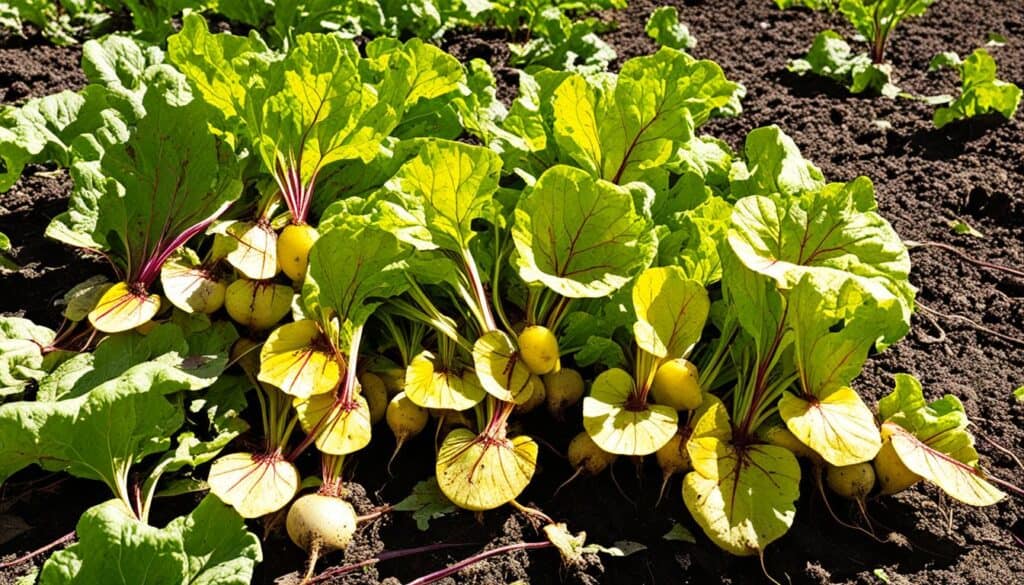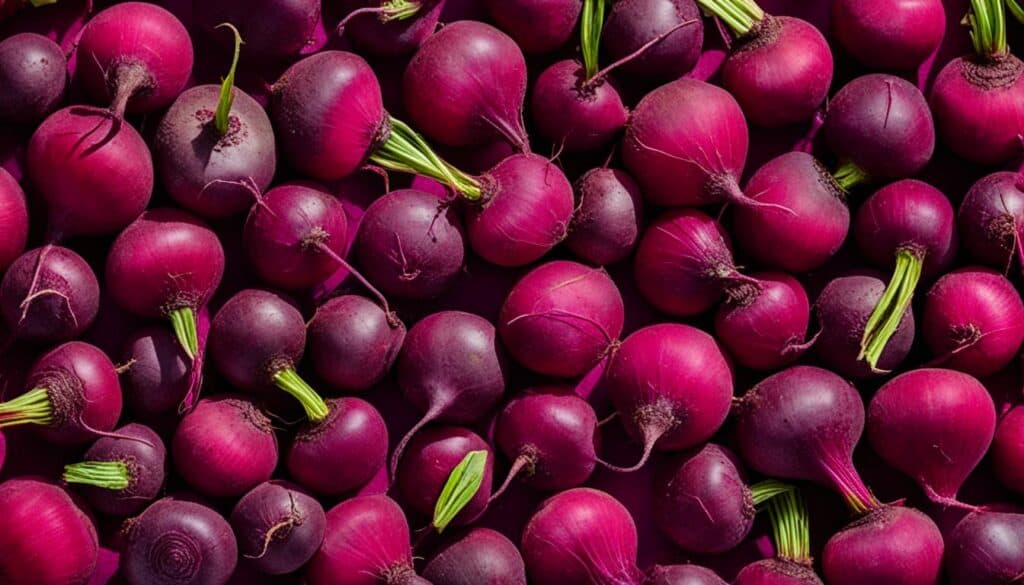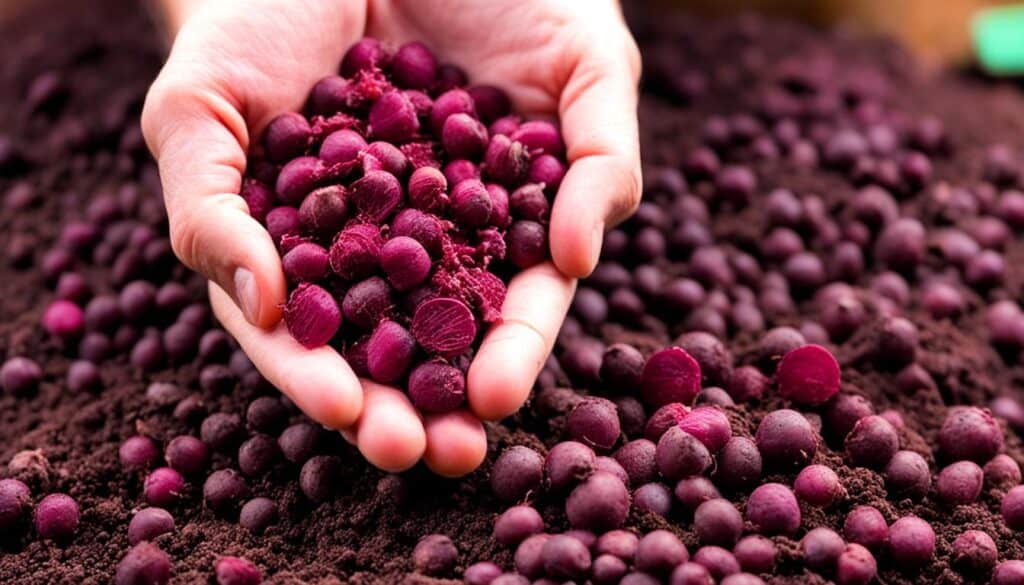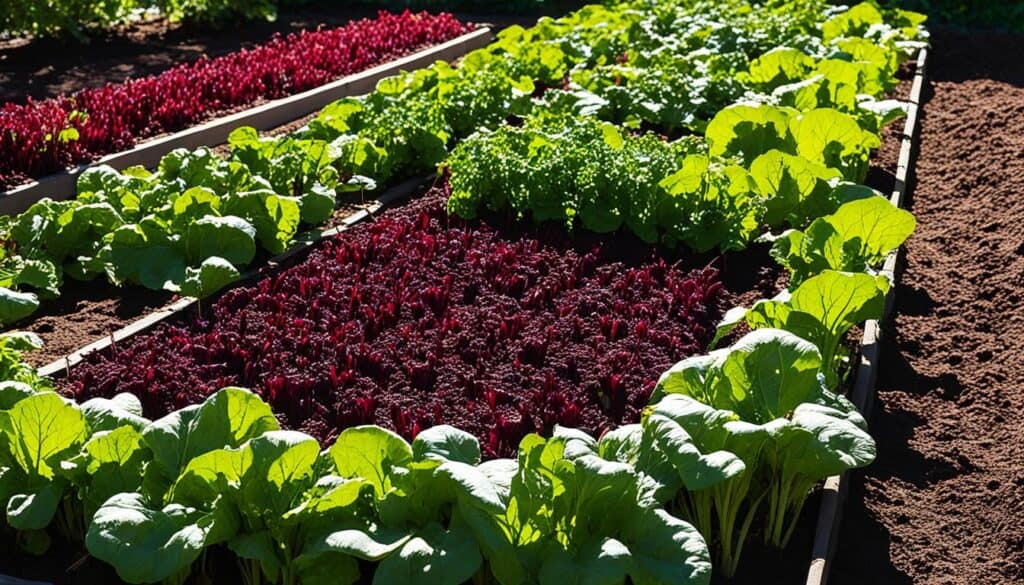Did you know that beets are not only delicious but also incredibly nutritious? These vibrant root vegetables are packed with fiber, vitamins A and C, and iron. But here’s the surprising part: beets are also rich in antioxidants, which can help fight inflammation and promote heart health.
If you’re looking to grow your own beets, choosing the right seeds is essential. That’s why I’ve compiled a list of my top beet seed picks, including organic, non-GMO, and heirloom varieties. Whether you’re a seasoned gardener or a beginner, these seeds will ensure a bountiful harvest of high-quality beets.
Key Takeaways:
- Beets are not only delicious but also highly nutritious, packed with fiber, vitamins A and C, and iron.
- Choosing the right beet seeds is crucial for a successful harvest.
- Consider opting for organic, non-GMO, and heirloom beet seeds for premium quality and flavor.
- Be sure to explore reputable online sources to buy the best beet seeds for your garden.
- Growing your own beets allows you to enjoy a wide variety of colors and flavors, adding versatility to your culinary creations.
Tips for Starting Beet Seeds Indoors
When it comes to growing beets, starting from seeds indoors is a great way to get a head start on the growing season. Here are some tips to help you successfully start beet seeds indoors:
- Use a seed tray: Choose a seed tray or seedling flats with adequate drainage to ensure proper moisture levels for your beet seeds’ germination.
- Fill with organic garden soil: Fill the seed tray with high-quality organic garden soil. This will provide the necessary nutrients for healthy seedling growth.
- Sow beet seeds 1 inch apart: Gently press the beet seeds into the soil, spacing them about 1 inch apart. This allows enough room for the seedlings to develop without overcrowding.
- Find a warm, sunny locale: Place the seed tray in a warm, sunny area. Beets thrive in temperatures above 50 degrees Fahrenheit, so choose a location that provides ample sunlight.
- Keep the soil moist: Water the seed tray regularly to keep the soil consistently moist. Avoid overwatering, as this can lead to seed rot.
- Transplant seedlings: Once the seedlings reach about 2 inches tall and outdoor temperatures are consistently above 50 degrees Fahrenheit, it’s time to transplant them. Gently remove the seedlings from the seed tray and transplant them into your garden or larger pots.
Starting beet seeds indoors gives you a head start on the growing season and allows you to control the conditions for optimal germination. With the right seed tray, organic garden soil, and a warm sunny locale, you’ll be well on your way to growing healthy beet seedlings ready for transplanting.
Direct Sowing Beet Seeds in the Ground
When it comes to growing beets, direct sowing is a popular method that yields great results. It’s a simple and straightforward process that allows you to sow beet seeds directly into the ground or raised beds. Here’s how you can do it:
Step 1: Prepare the Soil
Start by preparing the soil for your beet seeds. The soil should be well-draining and loose to allow the roots to grow properly. Remove any weeds or debris from the planting area.
Step 2: Sow the Seeds
Take your beet seeds and sow them directly into the ground. Make a furrow that is about 1 inch deep and 3 to 4 inches apart. Drop the seeds into the furrow, spacing them evenly.
Step 3: Cover and Mulch
Lightly cover the beet seeds with soil, ensuring they are adequately covered but not too deeply buried. This will provide the seeds with the necessary protection and support for germination.
Next, add a layer of grass clippings or mulch over the planted area. This will help retain moisture in the soil and prevent weed growth. Mulching also helps to regulate the soil temperature, creating an optimal growing environment for your beets.
Step 4: Thinning Beets
After about 2 or 3 weeks, your beet seeds will begin to germinate and sprout into seedlings. They will start growing closely together, so it’s important to thin them out to give each plant enough space to thrive.
“Thinning beets is a crucial step to ensure healthy growth and avoid overcrowding. This allows the remaining plants to develop strong roots and produce larger beets.”
To thin your beets, snip off the unwanted shoots, leaving a gap of 3 to 4 inches between each remaining plant. This will prevent competition for resources and encourage optimal growth.
By following these steps, you can successfully sow beet seeds directly in the ground and enjoy a bountiful harvest of fresh, delicious beets!
Container Planting for Beets
If you don’t have a garden or limited space, don’t worry! Beets can be easily grown in containers, making them a great option for container gardening enthusiasts. Container planting allows you to enjoy fresh, homegrown beets without the need for a large outdoor space.
When planting beets in containers, it’s important to follow the same process as direct sowing in the ground. Here are some key considerations for successful container planting:
Choosing the Right Container
Opt for a container that is at least 8 inches deep to accommodate the beet roots. A wider container will allow for more even growth. You can choose between ceramic or plastic pots, but make sure they have drainage holes to prevent waterlogging.
Moisture Level and Watering
Beets in containers require more frequent watering than those planted in the ground. Check the moisture level of the soil regularly and water whenever the top inch feels dry. Maintaining adequate moisture levels is crucial for healthy beet growth.
Proper Spacing
Beets need enough space to grow and develop their roots properly. Plant each beet seedling 3 to 4 inches apart in the container to allow enough room for the plants to thrive. If the container is wide enough, you can plant multiple rows of beets with a spacing of at least 6 inches between rows.
Thinning as Beets Grow
Thinning is an essential step in container planting to prevent overcrowding and ensure proper nutrition for the remaining plants. Once the beet seedlings reach a height of 2 to 3 inches, gently thin them out, leaving only the healthiest and most vigorous plants in the container. Thinning allows the beets to grow to their full potential and reduces competition for resources.
| Container Planting Tips for Beets |
|---|
| Choose a container that is at least 8 inches deep |
| Ensure the container has drainage holes |
| Regularly check and maintain the moisture level of the soil |
| Water whenever the top inch of soil feels dry |
| Plant beet seedlings 3 to 4 inches apart |
| Thinning is necessary to prevent overcrowding |
Container planting offers the convenience of growing beets in smaller spaces, such as balconies, patios, or even indoors. Just make sure your container gets enough sunlight, and you’ll be rewarded with a bountiful harvest of delicious, homegrown beets.
Common Problems When Growing Beets
While growing beets can be a rewarding experience, there are several common problems that gardeners may encounter. Pests and diseases can wreak havoc on your beet plants, affecting their growth and overall health. To help you address these issues and ensure a successful beet harvest, here are some of the common problems that you may encounter and how to tackle them:
Pests
Beets are susceptible to various pests, including leaf hoppers, aphids, and flea beetles. These pests can cause damage to the leaves and stems of your beet plants, hindering their development. To tackle pest infestations, try using homemade sprays such as garlic spray or pepper spray. These natural remedies can help repel pests and protect your beets without the need for harsh chemicals. Before applying the spray on your entire garden, test it on a small area first to ensure it doesn’t cause any harm to the plants.
Diseases
Beets can also fall prey to diseases like damping off, beet mosaic, and black root. Damping off is a fungal disease that can affect young beet seedlings, causing them to wilt and die. Beet mosaic is a viral disease that leads to mottled leaves and stunted growth. Black root, on the other hand, affects the roots of beets, causing them to turn black and rot. To prevent disease, ensure that your beets are planted in well-draining soil and practice good sanitation. Remove any infected plants promptly to prevent the spread of disease.
Garlic Spray and Pepper Spray
Garlic Spray: To make garlic spray, blend several cloves of garlic with water and strain the mixture. Dilute the garlic mixture with water, then add a small amount of liquid soap to enhance its effectiveness. Spray this mixture on your beet plants, focusing on the leaves and stems to repel pests.
Pepper Spray: To make pepper spray, blend hot peppers (such as jalapenos or cayenne peppers) with water and strain the mixture. Dilute the pepper mixture with water and add a small amount of liquid soap. Spray this mixture on your beets to deter pests and protect your plants.
Remember to always wear protective gloves and avoid contact with your eyes or skin when handling and applying these sprays.
Common Problems and Solutions for Growing Beets
| Problem | Solution |
|---|---|
| Pest Infestations | Use homemade garlic or pepper spray to repel pests. Test the spray on a small area before applying it to the entire garden. |
| Damping Off | Plant beet seeds in well-draining soil and ensure proper ventilation to prevent fungal growth. Remove infected seedlings promptly. |
| Beet Mosaic | Avoid planting beets near infected plants. Remove and destroy any infected plants to prevent the spread of the virus. |
| Black Root | Plant beets in well-draining soil and avoid overwatering. Remove and destroy infected plants to prevent further damage. |
Best Varieties of Beets to Plant
When it comes to choosing which beet varieties to plant in your garden, there are several options that are sure to please both your taste buds and your visual senses. Here are some popular choices:
- Bulls Blood: Known for its striking dark red foliage, the Bulls Blood beet variety adds both color and flavor to your dishes.
- Chioggia: This Italian heirloom variety features beautiful pink and white concentric rings when sliced, making it a visually stunning addition to salads.
- Detroit Dark Red: A classic variety, the Detroit Dark Red beet is known for its vibrant deep red color and sweet, earthy flavor.
- Golden Heirloom: For a golden twist on the traditional beet, try growing the Golden Heirloom variety. Its bright yellow flesh adds a pop of color to any dish.
- Boldor: With its vibrant orange skin and flesh, the Boldor beet variety is not only visually appealing but also has a sweet and tender taste.
- Avalanche: If you’re looking for a white beet variety, the Avalanche is a great choice. Its creamy white color and mild flavor make it a versatile option for various dishes.
Choosing a beet variety pack is an excellent option for beginners who want to try different varieties and discover their preferences. It allows you to experiment with various flavors, colors, and textures, adding excitement to your garden and your plate.
By growing a diverse range of beet varieties, you can create a vibrant and flavorful palette of beets to enjoy throughout the growing season. From the deep red hues of Detroit Dark Red to the golden glow of Boldor, these varieties offer unique characteristics that cater to different culinary preferences and creative presentations.
Tips for Growing Healthy Beets
Beets are a thriving and nutritious addition to any garden. They flourish in warmer days, mild nights, and with steady moisture. Growing beets is a breeze and reaps numerous benefits, from adding vibrant color to your plate to providing essential nutrition.
When it comes to growing beets, ensuring the right growing conditions is key. Beets thrive in warmer temperatures during the day and milder temperatures at night. This combination promotes ideal growth and development, resulting in healthy and flavorful beets.
Consistent moisture is essential for growing beets. They require steady watering to maintain optimal growth. Aim to keep the soil consistently moist throughout the growing season. Avoid allowing the soil to become overly dry or waterlogged, as both conditions can hinder the growth of the beets. Regular watering will help ensure that the beets receive the proper moisture they need to thrive.
Not only do beets add a pop of color to your garden, but they also offer numerous nutritional benefits. They are rich in essential vitamins and minerals, including folate, potassium, and vitamin C. Adding beets to your diet can help support a healthy immune system, improve digestion, and promote overall well-being.
Once you experience the joy of growing your own beets, you won’t be able to resist their allure. Whether you’re a seasoned gardener or a beginner, growing beets is a rewarding and enjoyable experience.
Tips for Growing Healthy Beets:
- Ensure warmer days and mild nights for optimal growth
- Maintain consistent moisture by watering regularly
- Harvest beets at their peak for maximum color and nutrition
- Enjoy the benefits of homegrown beets in your favorite recipes
Experience the satisfaction of growing your own beets and enjoy the vibrant colors and nutritional goodness they bring to your plate.
Optimal Timing and Location for Planting Beets
When it comes to planting beets, timing and location play crucial roles in ensuring a successful harvest. Understanding the ideal conditions for beet seeds will help you maximize their growth and yield. Here are some key considerations:
Planting Timing:
Beet seeds can be planted approximately one month before the last spring frost in cooler areas. Beets are hardy vegetables that can tolerate a little frost and near-freezing temperatures. By planting them early, you can take advantage of the cooler weather and give your beets a head start.
Location:
Beets thrive in sunny locations with at least 6 hours of sunlight each day. Position them in a spot that receives ample sunlight to promote healthy growth and ensure optimal sugar production. Furthermore, beets prefer well-draining soil that allows excess water to flow away, preventing root rot and other water-related issues.
Soil Quality:
The quality of your soil is crucial for successful beet cultivation. Beets prefer rich, loose soil that provides good aeration and drainage. Before planting, enrich the soil with organic matter such as compost or well-rotted manure to improve its fertility and texture. This will create a favorable environment for the growth of your beet plants.
Companion Plants:
Companion planting can enhance the growth and productivity of your beets. Consider planting bush beans and onions near your beets. These companion plants provide mutual benefits, such as deterring pests and enhancing nutrient uptake. Additionally, the combination of beets, bush beans, and onions can create a visually appealing and harmonious garden layout
By paying attention to the optimal timing and location for planting beets, you can set the stage for a successful beet-growing journey. Providing your beets with the right amount of sunlight, well-draining soil, and suitable companion plants will help ensure healthy and productive plants.
How to Properly Plant Beet Seeds
Planting beet seeds correctly is essential for a successful harvest. Here are the step-by-step planting instructions to ensure your beet seeds thrive:
- Soaking the Seeds: Before planting, consider soaking the beet seeds in water for a few hours or overnight. This can help improve their germination rate and increase the chances of successful sprouting.
- Choosing the Right Location: Select a location with deep, fertile soil that is consistently moist. Beets prefer full sun but will tolerate partial shade.
- Sowing the Seeds: Plant the beet seeds directly in the prepared soil. Make sure the soil is loosened and free of debris. Sow the seeds about 1/2 inch deep and space them 2 to 4 inches apart.
- Thinning the Seedlings: Once the beet seedlings reach a height of 2 to 3 inches, thin them out to allow proper root development. Remove the weaker or overcrowded seedlings, leaving only the strongest ones. This will ensure healthier plants and better yields.
- Square Foot Gardening: Consider using the square foot gardening method for efficient spacing. Plant your beet seeds in a grid pattern, allowing each plant to have enough space to grow and access nutrients.
Following these planting instructions will give your beet seeds the best start and increase the likelihood of a successful and abundant beet harvest.
Beet Planting Instructions
| Step | Instructions |
|---|---|
| 1 | Soak the beet seeds in water for a few hours or overnight. |
| 2 | Select a location with deep, fertile soil and consistent moisture. |
| 3 | Plant beet seeds about 1/2 inch deep and 2 to 4 inches apart. |
| 4 | Thin the seedlings when they are 2-3 inches tall. |
| 5 | Consider square foot gardening for efficient spacing. |
Care and Maintenance for Growing Beets
Proper care and maintenance are essential for successfully growing beets. By following a few key practices, you can ensure the health and productivity of your beet plants. Here are some important tips:
- Watering: Beets require consistent watering, especially during warm weather. Keep the soil evenly moist, but be careful not to overwater, as this can lead to rotting. Regularly check the moisture level of the soil and adjust your watering schedule accordingly.
- Mulching: Mulching is beneficial for growing beets as it helps keep the soil cool and retains moisture. Apply a layer of organic mulch around the base of the plants, such as straw or shredded leaves. This will also help suppress weed growth and reduce the need for frequent watering.
- Pest Prevention: To prevent pests from damaging your beet plants, it’s important to regularly inspect them for signs of infestation. Remove any damaged or infested leaves immediately to prevent the spread of pests. Consider using natural pest control methods such as homemade garlic spray or pepper spray to deter common beet pests like leaf hoppers, aphids, and flea beetles.
- Leaf Removal: Removing damaged or diseased leaves from your beet plants is crucial for maintaining their overall health. This will help prevent the spread of diseases and pests and encourage the growth of new, healthy leaves. Use a sharp pair of scissors or pruning shears to carefully remove any affected foliage.
- Soil Fertility: Beets thrive in nutrient-rich soil. Before planting, amend your soil with organic matter such as compost or well-rotted manure to improve its fertility. This will provide the necessary nutrients for healthy beet growth. If your soil is lacking in fertility, consider using a balanced organic fertilizer during the growing season.
Following these care and maintenance practices will help you grow robust and flavorful beets in your garden. With proper watering, mulching, pest prevention, leaf removal, and attention to soil fertility, your beet plants will flourish and reward you with a bountiful harvest.
Keep up the good work and enjoy the process of growing your own nutritious and delicious beets!
Harvesting and Using Beets
When it comes to harvesting beets, there are a few key things to keep in mind. First, beet greens can be harvested as soon as they are large enough to use. These vibrant and nutritious greens can be added to salads or sautéed as a side dish.
For the beets themselves, most varieties are ready to harvest when they reach a root size of 1-2 inches in diameter. At this stage, they are tender, flavorful, and perfect for enjoying in various dishes.
When harvesting beets, it’s important to leave about an inch of the top intact. This prevents “bleeding,” which is when the color from the beet root seeps out. By leaving a small portion of the top, you can retain the vibrant color and prevent any mess.
Once harvested, beets can be stored in a cool, dry place. This can be a cellar, basement, or even the refrigerator. Proper storage helps to prolong their freshness and maintain their flavor.
Now that you have a bountiful harvest of beets, it’s time to put them to delicious use in the kitchen. Beets can be cooked in a variety of ways, making them a versatile ingredient in both savory and sweet recipes.
For savory options, try roasting beets in the oven or boiling them until tender. They can be added to salads, used as a topping for pizzas, or pureed into flavorful dips and spreads. Beets can also be pickled, offering a tangy and slightly sweet addition to sandwiches and charcuterie boards.
When it comes to sweet treats, beets can be incorporated into baked goods like cakes, muffins, and brownies. Their natural sweetness adds a unique twist to these classic recipes, while also providing a boost of nutrients.
Whether you’re a fan of beet greens or love experimenting with different beet recipes, this versatile vegetable offers plenty of culinary possibilities. From salads to pickles, and everything in between, beets are sure to add a pop of color and flavor to your dishes.
Benefits of Using Beets:
- Rich in fiber, vitamins A and C, and iron
- High in antioxidants
- Versatile ingredient in both savory and sweet recipes
- Can be harvested for both the greens and root
- Offers vibrant color and unique flavor
Conclusion
Growing beets from seeds is a rewarding experience. By following the proper planting techniques, caring for your plants, and harvesting at the right time, you can enjoy a bountiful harvest of delicious and nutritious beets.
Beet seeds offer a wide range of possibilities, from organic and non-GMO options to heirloom varieties. Whether you choose to buy beet seeds online or search for the best beet seeds locally, there are plenty of high-quality options available.
Remember, successful beet growing requires attention to detail and consistent care. From starting beet seeds indoors to direct sowing in the ground or containers, each step plays a vital role in the growth and development of your beets. By providing the right environment, including proper sun exposure, soil quality, and companion plants, you can optimize your beet growing experience.
Once your beets are ready for harvest, the true rewards begin. Experiment with different cooking methods to fully enjoy the versatility of this vegetable. From roasted beets to beet salads and pickles, there are countless ways to incorporate these nutrient-rich delights into your meals. Share your successful beet growing journey with friends and family, and inspire others to join the wonderful world of beet cultivation.










Leave a Reply